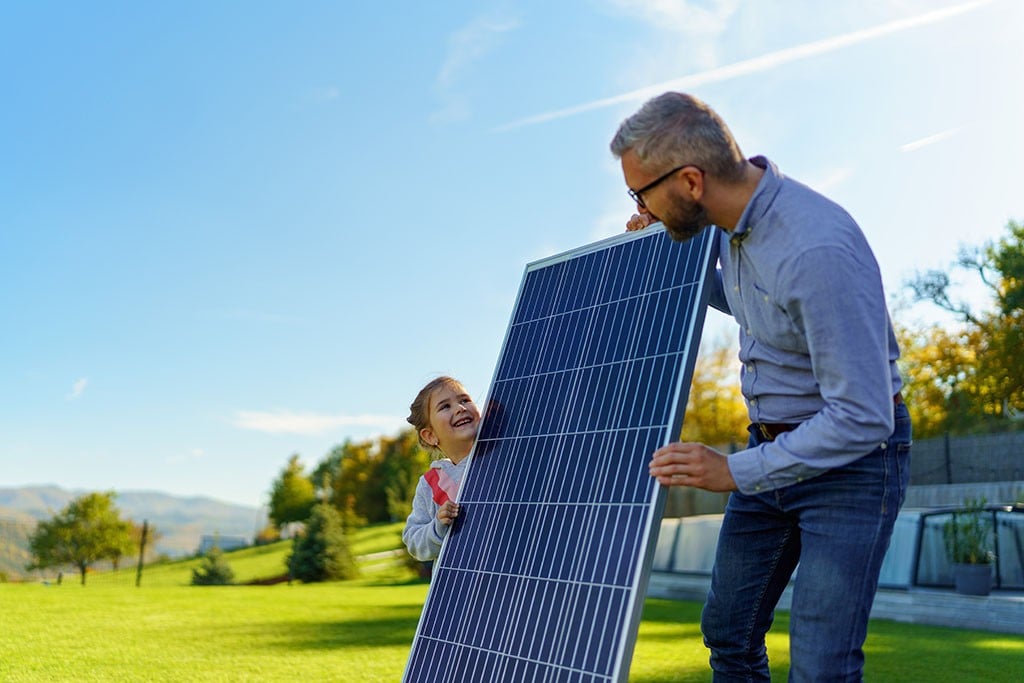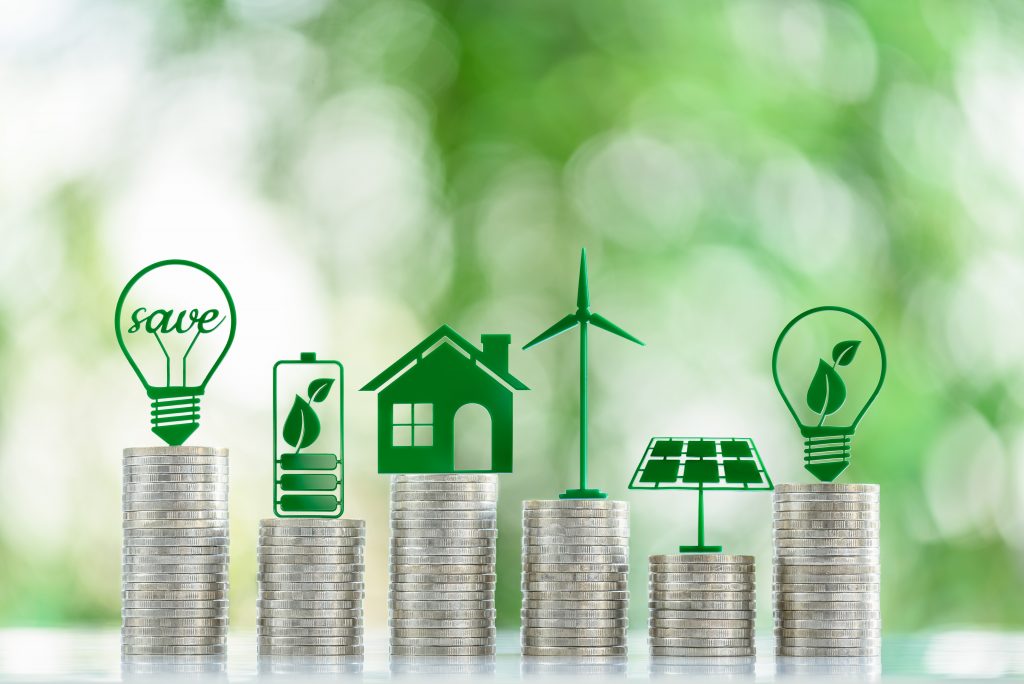
Backup Power, Batteries, DIY Solar Tips, Grid-Tie Solar, Off-Grid Solar, Renewable Energy, Solar Panels, Solar Power, Videos
Installing solar panels on your house is a great way to cut down on energy expenses and help the environment. Solar panels have gained momentum in recent years, and countless homeowners are now turning to them as an alternate source of power. Whether you’re wanting to save money on electricity bills or do your bit for nature, putting up solar panels at home is a solid decision. In this blog article, we’ll look into the pros, costs, and DIY instructions for installing solar panels at home.
The Benefits of Solar Energy

Solar energy’s popularity has grown in recent years, partly due to the financial benefits and lower utility bills associated with it. Savings can vary depending on electricity consumption, solar energy system size, purchase or lease options, daily sunlight hours, roof size and angle, and local rates.
Solar power is viewed as an upgrade to one’s residence. The United States boasts a colossal solar resource, thus even places with relatively small amounts of solar resources can experience monetary savings. Every kWh of solar energy created will also decline greenhouse gas effusions and other grave pollutants as well as lessen water usage and extraction.
For those looking to put in solar panels in their home, something as small as 100 watt solar panels and 24 volt electrical storage batteries could serve as a good beginning. If you need greater power, then beefing up to 300 watt solar panels or larger with a sun-following system may be worth considering.
Check out our “Top Ten Reasons Why You Should Install Home Solar Panels” for more on the benefits of home solar.
How to find the best solar system for you

The first question you want to ask yourself is, who will install the system? Do you want to hire a solar pro? If so, read our in depth guide to finding the right solar installer for you!
Do you want to do-it-yourself? Awesome, we have all the resources you’ll need to get up to speed.
The next step is to figure out what kind of system you want. There are several different types of solar systems available, depending on your specific needs. Are you looking to build a small, portable solar generator or looking for a permanent whole home system?
Off-grid solar systems have no connection to the utility grid and must make all the electricity necessary for the home. Grid plus battery backup systems can be used to add backup power to a grid-tie solar system. Grid-tie solar systems are designed for those who already have electric utility service and wish to reduce their electric bill.
When selecting a solar system, you should consider how much you’ll need, what type of solar panels you want, and whether you need a battery for storage. Our solar calculators can help your figure that out.
You should also consider the type of mounting system you’ll use. Options include sun tracking systems and stationary systems. Sun tracking systems use sensors to detect the sun’s position and adjust the angle of the panels throughout the day for optimal energy production. Stationary mounting systems remain in one position throughout the day.
Finally, consider adding solar batteries for storage if you need a more reliable source of electricity when the sun isn’t shining. Common types of batteries for home solar systems include 12v and 24v batteries to larger 48v batteries.
Once you’ve determined which type of system best suits your needs, it’s important to understand how a solar panel works, what types of solar panels are available, and how to safely install the system. altE can help you find a professional installer to get the most out of your home solar power system if you don’t want to install it yourself.
The Cost of Solar Energy
Are you asking yourself “how much for solar panels?”
When it comes to installing solar panels at home, there are a few things to consider. The first is the cost of the system itself. Solar panel systems can range from a few hundred dollars for a small DIY setup to tens of thousands of dollars for larger systems.
The size and complexity of the system will also determine the cost. It is important to do your research and find out what type of system you need for your home in order to get the most benefit from it.
With solar energy, the costs and pricing estimates vary by state and region. Regions with higher usage and more sunny days per year tend to have more robust incentive programs in place that may make solar energy more accessible. However, other areas of the U.S. may not have the same level of development for solar-powered solutions.
How much you can expect to pay for a solar panel system is dependent on the number of panels required to meet your energy needs, the type of solar panel you choose, and the incentives available in your region. However, according to Forbes, “Solar panels cost, on average, about $16,000, or between $3,500 to $35,000 depending on the type and model.” That’s quite a range!
When considering the cost of solar energy, you may want to consider looking into wholesale options, as this may be the most cost-effective route. A solar wholesaler like altE can offer competitive pricing on solar systems for homes and help with understanding how a solar panel works and what components are needed to create a complete system.
At altE Store, our smallest tiny house kits start at $2,500 and our Grid-Tied 10kW Residential Home Solar System with Battery Backup is around $26,000. This of course doesn’t include the labor cost to install the system, or other costs like permits. But the sky is the limit and we can design a perfect system for nearly any budget. Browse our large selection of solar power kits, send a quote request for a custom kit or give us a call and we’ll help you design the prefect system.
When it comes to installing solar panels at home, there are a few things to consider. The first is the cost of the system itself. Solar panel systems can range from a few hundred dollars for a small DIY setup to tens of thousands of dollars for larger systems.
When it comes to installing solar panels at home, the size and complexity of the system will determine the cost. It is important to do your research and find out what type of system you need for your home in order to get the most benefit from it.
The Process of Installing Solar Panels

Installing solar panels in your home is a great way to save money and reduce your carbon footprint. However, it is important to understand the process of installation before making any decisions.
First, you’ll need to decide which type of solar panel best suits your needs. There are several options available, from smaller than 100watt solar panels to larger than 300w solar panels, flexible solar panels, bifacial solar panels, and more. Each type has its own pro’s and con’s, so it’s important to consider which type will be most suitable for your home.
In general flexible solar panels are less efficient than traditional solar modules and don’t have very long warranties. Bifacial solar panels work best when you have a reflective surface behind them, like a white roof or light colored gravel. Most people go with traditional solar panels as they have the best price points and functionality in most circumstances.
Next, you’ll need to choose how much power you want to generate with your solar panels. You can either purchase a solar system for homes that comes with a certain number of panels and an inverter, or purchase each component separately and assemble your own system. In either case, it is important to know how much power you will need before buying anything.
Once you’ve purchased all of the necessary components, you’ll need to install them. Depending on where you live, you may be able to do the installation yourself or hire a professional. If you decide to do the installation yourself, make sure to read up on safety guidelines and double-check all connections before turning on your system.
If you plan on having a battery bank for your home solar power system, it’s essential to research the right type of batteries for home solar. The most common type is a 24V battery, although there are other options available depending on how much energy you want to store and how much you’re willing to spend.
By following these steps and researching the various components involved in a home solar power system, you can ensure that your system will be both safe and efficient. With the right preparation and planning, you’ll be able to enjoy the many benefits of a solar powered home for years to come!
Do-It-Yourself Tips for Installing Solar Panels

Installing solar panels at home is a great way to save money on electricity and reduce your carbon footprint. You can also find many benefits from solar energy, such as independence from the grid and increased home value. But before you begin your solar project, it’s important to understand how much solar energy you need, the cost of solar energy, and the process of installing solar panels.
When installing solar panels at home, it’s best to start by doing some research to determine what type of system is right for your home. Solar powered systems come in a variety of sizes and shapes, ranging from micro systems with 100Watt solar panels or smaller to gigawatt plus utility scale power plants!
Once you’ve decided how much power you need, you’ll need to find out how much for solar panels and other equipment like a 12v or 24V battery, a home inverter, and batteries for your home solar system.
Once you’ve chosen the right equipment, it’s time to purchase the supplies and begin installation. You can purchase the equipment from a solar wholesaler, like altE, online or on the phone. Make sure to read up on how a solar panel works and the basics of wiring a home solar power system so that you know what to expect during installation.
Once all of the solar components are installed, it’s important to consider a battery bank for your home solar system. This will store any excess energy your home produces for later use. Choosing the right batteries for your home solar system is key; look for high quality batteries that are rated for long-term use and make sure to research their warranties before making your purchase.
Installing solar panels at home can seem intimidating, but with the right preparation and research, it doesn’t have to be. By following these do-it-yourself tips for installing solar panels, you’ll be well on your way to creating a successful and sustainable home solar system. And if you decide the DIY route is not for you, give us a call and we’ll work to find a solar pro in your area to help.
Wrapping things up
Many people around the world are looking for ways to become more energy efficient. One of the best methods is to install solar panels at home. Installing solar panels at home can be a great way to reduce your energy costs, help the environment, and have the freedom to create your own energy source.
Whether you decide to purchase the panels from a solar panel wholesale supplier and install them yourself or get a solar installation professional to do the work, the end result is a reliable source of clean energy. Additionally, you can pair the panels with a battery bank to store excess energy. Getting a solar panel with battery bank makes for a combo so you always have power when you need it. With some research and preparation, anyone can make their house solar powered in no time.
Deciding to use solar power to power and convert your home to a solar house is a smart choice and investing in solar panels is an excellent way to save money in the long run. Solar panels are an efficient, eco-friendly way to power your home, so consider giving them a try. With the right solar batteries for homes, you can start seeing the benefits of going solar almost immediately.
Using solar power for your home has many benefits. Solar energy is a renewable, clean source of energy that can help reduce your electricity bills and your carbon footprint. Solar panels are becoming increasingly affordable and easy to install, making them an attractive option for homeowners looking to save money and reduce their environmental impact.
Most people choose to go solar for the following reasons:
1) Lower electricity bills – Depending on the amount of electricity you use each month, installing a system can result in a significant reduction in your power bills as it will rely less on grid electricity.
2) Environmental friendly – Solar panels rely on clean renewable energy sources rather than polluting fossil fuels used by most power utilities. This makes installing a system one of the simplest ways to reduce your carbon footprint and have less impact on our environment.
3) Tax credits and incentives– Many nations offer tax credits or other financial incentives when you install a solar panel system in your home or business premises. These incentives help offset initial installation costs.
Once you have the necessary information, you can begin to plan your solar panel installation. Start by researching the types of panels available and their associated costs. You should also consider the size of your home and how much energy you will need to power it. This will help you determine how many panels you need and what type of system would be best for your needs.
Next, decide whether you want to install the solar panels yourself or hire a professional installer. If you choose to do it yourself, make sure that you understand all safety precautions and follow all instructions carefully. You may also want to consult with an electrician before beginning any work on the wiring or electrical components of your system.
Finally, once everything is in place, connect the solar panels to your home’s electrical system and start enjoying clean energy from the sun! With proper maintenance, your solar panel system should last for decades and provide a reliable source of renewable energy for years to come.

